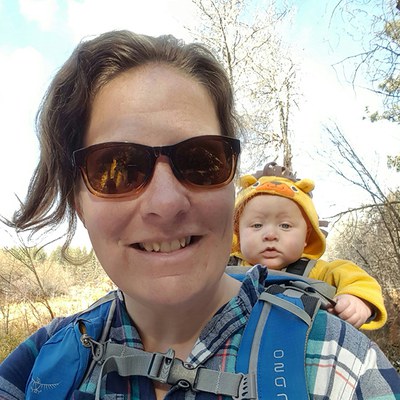If you visit the Metolius River or its side creeks in the fall, you'll undoubtedly see an influx of dead fish along the shore. Many of those fish are kokanee who have spawned and are now finishing their life cycle by contributing nutrients to the soil and water. What's a kokanee and how is it different from sockeye? We've got your answers! Local fish biologist Megan Hill offers a guest blog post on the broader story of kokanee and sockeye in Central Oregon.
Let’s start with our vision for the future: we want to see strong runs of migratory sockeye in the Metolius River region and robust populations of kokanee in Lake Billy Chinook. To reach that goal we’ve got to look back to the past.
Historically, Metolius River sockeye spawned and laid their eggs in Link Creek, upstream of Suttle Lake. After hatching, the juveniles would move into the lake to grow. The following spring, these juveniles began their journey downstream to the ocean. In the ocean, they found plentiful food, more than was available in freshwater. After feeding in the Pacific for two years they would head back to Link Creek to spawn in the fall, starting the process over again.
This natural cycle was disrupted as early as the 1930’s with the construction of Lake Creek Lodge and dams at the outlet of Suttle Lake. As a result, sockeye numbers in the Metolius River plummeted. Hatchery stocking allowed the fishery to eek along in the following decades. However, in the 1960’s, Portland General Electric (PGE) constructed a series of dams on the Deschutes River, the Pelton Round Butte project. These dams effectively ended sockeye runs in the Metolius River region.
And yet, sockeye persisted, adapting to their new environment by transforming into kokanee. Instead of traveling to the ocean, kokanee migrate to freshwater lakes to mature. Lake Billy Chinook, the reservoir formed by Round Butte dam, provides this habitat for Metolius River kokanee.
In 2010, PGE and the Confederated Tribes of Warm Springs (co-owners of the dams since the 1980s) constructed fish passage facilities at Round Butte Dam. The ocean was now reachable again, giving kokanee a choice: stay in the reservoir, or journey to the ocean and return as sockeye. Every year, thousands of fish take each path. Lake Billy Chinook continues to support robust kokanee populations. In addition, thousands of juveniles enter fish passage facilities on their way downstream each spring. Two years later, the hardiest adults return home as sockeye to spawn in and around the Metolius River.
While we celebrate restoring fish passage for sockeye, we also know we have a long way to go to achieve our goal of robust sockeye and kokanee populations regionally. The Pelton Round Butte Fish Committee has identified several strategies to help us get there. Some of these actions, like changing how and when we move fish around the dams, necessitate action by PGE and the Tribes as dam owners. Other tactics, like improving fish habitat, depend on the work of nonprofits like the Deschutes Land Trust. But we still have a lot to learn about sockeye reintroduction--the Tribes’ Natural Resources Department is leading the way here. They are looking to other river basins to learn from their successes and challenges and researching the genetic complexities of the sockeye/kokanee decision. This research may lead sockeye reintroduction in a new direction.
Sockeye populations are notoriously volatile, and we know that progress won’t be straightforward. Climate change and poor ocean conditions pose real challenges to recovery. However, I believe our collective actions to improve fish habitat and open up passage provide a hopeful future for sockeye in the Metolius. Megan Hill has been studying Central Oregon fisheries since 2007, currently working as the fisheries manager for Portland General Electric’s Deschutes Hydroelectric Project. Throughout her career at PGE, Megan has had the opportunity to snorkel, conduct juvenile fish surveys, and locate spawning salmon and steelhead in the Metolius River and Whychus Creek. Megan also leads salmon walks for the Land Trust.
Megan Hill has been studying Central Oregon fisheries since 2007, currently working as the fisheries manager for Portland General Electric’s Deschutes Hydroelectric Project. Throughout her career at PGE, Megan has had the opportunity to snorkel, conduct juvenile fish surveys, and locate spawning salmon and steelhead in the Metolius River and Whychus Creek. Megan also leads salmon walks for the Land Trust.
Learn more:


